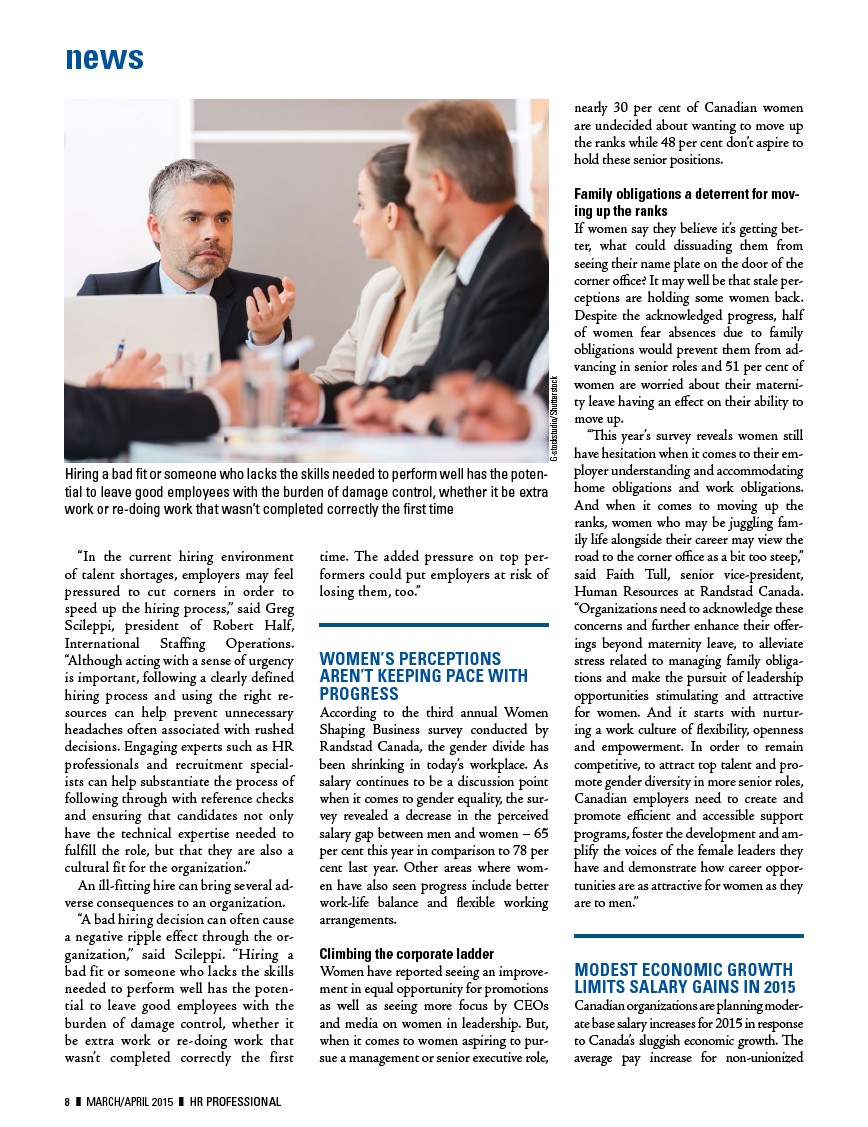
news
Hiring a bad fit or someone who lacks the skills needed to perform well has the potential
to leave good employees with the burden of damage control, whether it be extra
work or re-doing work that wasn’t completed correctly the first time
“In the current hiring environment
of talent shortages, employers may feel
pressured to cut corners in order to
speed up the hiring process,” said Greg
Scileppi, president of Robert Half,
International Staffing Operations.
“Although acting with a sense of urgency
is important, following a clearly defined
hiring process and using the right resources
can help prevent unnecessary
headaches often associated with rushed
decisions. Engaging experts such as HR
professionals and recruitment specialists
can help substantiate the process of
following through with reference checks
and ensuring that candidates not only
have the technical expertise needed to
fulfill the role, but that they are also a
cultural fit for the organization.”
An ill-fitting hire can bring several adverse
consequences to an organization.
“A bad hiring decision can often cause
a negative ripple effect through the organization,”
said Scileppi. “Hiring a
bad fit or someone who lacks the skills
needed to perform well has the potential
to leave good employees with the
burden of damage control, whether it
be extra work or re-doing work that
wasn’t completed correctly the first
G-stockstudio/Shutterstock
time. The added pressure on top performers
could put employers at risk of
losing them, too.”
WOMEN’S PERCEPTIONS
AREN’T KEEPING PACE WITH
PROGRESS
According to the third annual Women
Shaping Business survey conducted by
Randstad Canada, the gender divide has
been shrinking in today’s workplace. As
salary continues to be a discussion point
when it comes to gender equality, the survey
revealed a decrease in the perceived
salary gap between men and women – 65
per cent this year in comparison to 78 per
cent last year. Other areas where women
have also seen progress include better
work-life balance and flexible working
arrangements.
Climbing the corporate ladder
Women have reported seeing an improvement
in equal opportunity for promotions
as well as seeing more focus by CEOs
and media on women in leadership. But,
when it comes to women aspiring to pursue
a management or senior executive role,
nearly 30 per cent of Canadian women
are undecided about wanting to move up
the ranks while 48 per cent don’t aspire to
hold these senior positions.
Family obligations a deterrent for moving
up the ranks
If women say they believe it’s getting better,
what could dissuading them from
seeing their name plate on the door of the
corner office? It may well be that stale perceptions
are holding some women back.
Despite the acknowledged progress, half
of women fear absences due to family
obligations would prevent them from advancing
in senior roles and 51 per cent of
women are worried about their maternity
leave having an effect on their ability to
move up.
“This year’s survey reveals women still
have hesitation when it comes to their employer
understanding and accommodating
home obligations and work obligations.
And when it comes to moving up the
ranks, women who may be juggling family
life alongside their career may view the
road to the corner office as a bit too steep,”
said Faith Tull, senior vice-president,
Human Resources at Randstad Canada.
“Organizations need to acknowledge these
concerns and further enhance their offerings
beyond maternity leave, to alleviate
stress related to managing family obligations
and make the pursuit of leadership
opportunities stimulating and attractive
for women. And it starts with nurturing
a work culture of flexibility, openness
and empowerment. In order to remain
competitive, to attract top talent and promote
gender diversity in more senior roles,
Canadian employers need to create and
promote efficient and accessible support
programs, foster the development and amplify
the voices of the female leaders they
have and demonstrate how career opportunities
are as attractive for women as they
are to men.”
MODEST ECONOMIC GROWTH
LIMITS SALARY GAINS IN 2015
Canadian organizations are planning moderate
base salary increases for 2015 in response
to Canada’s sluggish economic growth. The
average pay increase for non-unionized
8 ❚ MARCH/APRIL 2015 ❚ HR PROFESSIONAL